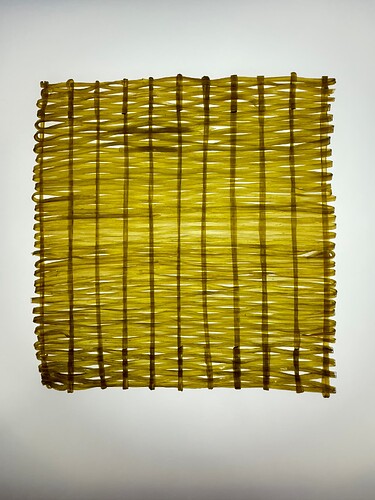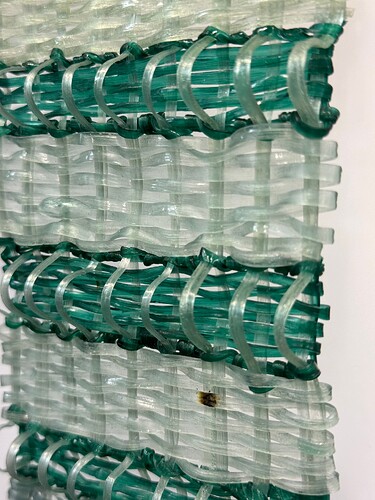I am interested in using your 3D printer to make a thread from a new experimental material made of Alginate, glycerine, and water. for the past year, I have been making this Alginate thread in my studio by hand by using a large syringe but the threads are too short for my weaving application. My intention is to make a continuous thread so i can use it on a loom.The process involves extruding the liquid solution into a bowl of Calcium Chloride, which makes it skin up immediately. I recently had a chance to try a 3D printer, (which was used for clay) at a University in North Carolina while i was visiting there and it worked quite well with my material but the size of the nozzle was too small for my application. So my questions are:
Has anyone there experience with this type of material in a 3D printer? Would it be possible to try your printer and if yes how would i go about doing that? My process does not involve heat so i could use an extruder of sorts. Can i come by and see the space? You can see a video of my 3D printer test on my Facebook page: 3D printed biomaterial solution made from seaweed. Very exciting. | By Nicole | Facebook, Looking forward to connecting with you. Nicole
It sounds like you need a paste extruder. All our working printers have filament extruders, and i don’t think they would handle any kind of liquid/goo being put into them.
We do have a non-functioning paste extruder printer that @Seloame has been slowly chipping away at getting it functional - but it could be quite a while before that’s in a usable state. Tho maybe if the goal is just getting extrusion working, that could happen quicker? If you’re game to try you’re welcome to become a member and get involved with that!
There are lots of 3d printable diy paste extruders out there, made to be attached to a printer gantry - but that may be more of a project than you are looking for (Search models | Printables.com and Search Thingiverse - Thingiverse). There are commercial ones available too that may be less of a project?
That looks like very cool bio-spaghetti! Please come check out the space and see if there are other tools here that can help you out in your exploration!
Out of curiosity, what weight/size of thread are you aiming for? Do you have a target size in Tex or denier? And what grams per square meter would you be aiming for with the woven fabric? The thread in the video is of sufficient thickness that I cannot really think of a comparable in the textile world. Did your North Carolina university trip involve visiting the textile department at the state university? Good luck finding a suitable loom and weaving procedure. ![]()
Hi Nicole,
Mike Vandermeer here.
I have done something similar with nylon polymer where the chemicals are pushed through a small nozzle into a bath of acid and then at the far end of the chemical tank the thread was taken up on a motorized spool. The tricky part was controlling the flow rate out of the nozzle so it stayed steady and then adjusting the take up speed of the spool to keep the thread properly suspended in the tank yet not pulling too hard on the thread while it hardened up. How long does it take for the alginate to become strong enough to hold its weight in the calcium chloride solution?
I am happy to brainstorm with you about this.
Cheers
Mike
Hi Emile: using the word “thread” is a bit of a misnomer because it is more akin to a yarn. I don’t have a comparable denier number but it is about 2 to 3 mm in diameter. so far i have used a simple hand loom but my plan is to use my table top loom with a large hole heddle. these are samples from the simple loom.
My North Carolina trip did not involve the textile department. I was in Wilmington to do a project that was performance based. see photo. I was given access to their maker lab for a few hours to run the test. What i learned was that the extruder worked but modifications would need to be done because my solution is much more viscous, than the usual clay that it was designed for. The solution leaked at the tube attachment and nozzle but that could be fixed with better seals. The other problem was that the nozzle was too small and i would need one twice as large. In the video the output size looks adequate but this solution shrinks a lot when drying. I am using a 60ml syringe with a wide tip because i found that smaller size yarn is less flexible and tends to break when drying. Also the extruder sometimes stopped for a few seconds so it did not make one long continuous thread. BTW i also make beads and sheets with this solution.
Hi Cory: thanks for those links. please see my reply to Emile for more info on how my preliminary tests went.
Hey Mike i will give you a call and we can brainstorm some ideas.
Excellent. This would be a good project for VHS electronics geniuses. They could perhaps help make a circuit that controls the flow rate from the nozzle using a stepper motor to press the plunger of a syringe at a controlled speed and another stepper motor on the take up spool at the other end of the reaction tank. There could be an idler wheel halfway between the nozzle and the take up spool that uses the weight of the thread to monitor the droop of the thread and speeds up the take up spool if there is too much droop, or slows it down if there is too much tension and thus too little droop.
One more thought: if you ever wanted to run some sort of workshop on these kinds of materials - I for one would love to see this stuff up close, and I would guess i’m not the only vhs member who would be interested.
Workshops can be held at the space by any keyholding member, and non-members or non-keyholders can hold workshops as long as there is a keyholder willing to be present during the workshop.
Anyway - just an idea! Do with it what you will - a few of us have been talking about having more workshoppy stuff happen at the space this year ![]()
@electron a kind note that this post is open to the internet so you may wish to dm your phone number and/or edit your post. Your choice, of course!
Thanks for the tip.
Cheers
Very cool photos and project. ![]()


